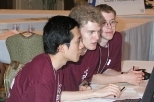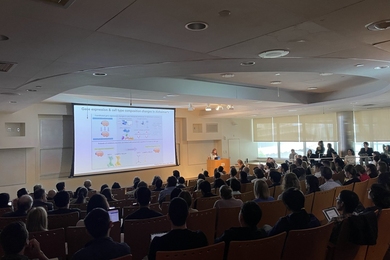It was a college student's dream: an expense-paid trip to Hawaii for spring break.
And three members of the MIT computer programming team got to make that trip to Honolulu, where they took second place in the world finals of the International Collegiate Programming Contest , the best finish for an MIT team in more than two decades. The Institute's team won the contest in 1978.
After winning the regional competition in Boston last fall, sophomores Percy Liang and John Danaher of electrical engineering and computer science (EECS) and freshman Reid Barton packed their bags and headed to Hawaii to compete against 64 universities. Associate Professor Martin Rinard of EECS coached the team, assisted by Vladimir Kiriansky, a senior in EECS.
More than 1,300 universities from 67 countries competed in the preliminary contests of the annual event, organized by the Association for Computing Machinery.
At the finals, each team was given a set of eight problems to solve over the course of five hours. Contestants were asked to write programs to calculate how much food was needed to cross a stretch of desert, how many inflated balloons could fit in a box, and an efficient way to provide Internet connections to a group of small Pacific islands.
While both programming ability and math skills were key to success, time management also was essential.
"With only one computer and three of us trying to solve problems at once, we had to figure out how best to use the two people who weren't typing," Danaher said. "You try to take things slowly, but especially when you're the one on the computer, there's always a voice telling you to hurry up so the team can move on to the next problem."
To prepare the team, student-coach Kiriansky set up simulated contests every Saturday for several months leading up to the finals. "Our success this year is due in no small part to Vladimir's effort and talent at leading the team through this training period and helping the members learn to work together effectively," said Rinard, who was especially impressed with the team's performance in the face of fierce competition.
"Computer science and computer technology are becoming more popular and available, increasing the pool of potential competitors. Many of our competitors come from educational systems in which they can devote the majority of their time to preparing for the competition," he said. "This competition attracts the very best programmers in the world and the MIT team is performing at a world-class level."
A team from Shanhai JiaoTong University came in first place, winning $10,000 and laptop computers. Each member of the MIT team won $2,000 and a new laptop, but the MIT-financed trip was the best prize of all.
"The weather couldn't have been better--80 degrees, sunshine every day," said Liang. "After the contest, we had three more days of sightseeing, swimming, kayaking, hiking and snorkeling. I was fine with it being part of my spring break."
A version of this article appeared in MIT Tech Talk on April 10, 2002.






